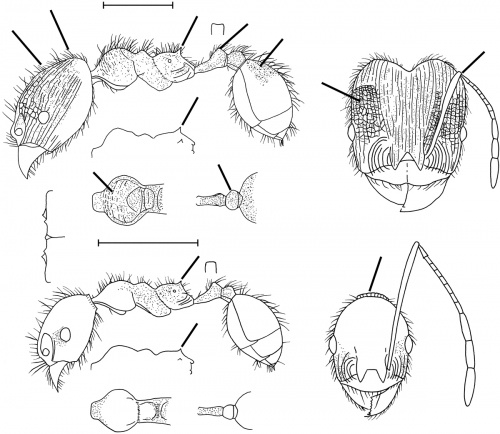Pheidole cardinalis
| Pheidole cardinalis | |
|---|---|
| Scientific classification | |
| Kingdom: | Animalia |
| Phylum: | Arthropoda |
| Class: | Insecta |
| Order: | Hymenoptera |
| Family: | Formicidae |
| Subfamily: | Myrmicinae |
| Tribe: | Attini |
| Genus: | Pheidole |
| Species: | P. cardinalis |
| Binomial name | |
| Pheidole cardinalis Wilson, 2003 | |
The type colony came from an earthen nest. (Wilson 2003)
Identification
See the description in the nomenclature section.
Keys including this Species
Distribution
Only known from the type locality.
Latitudinal Distribution Pattern
Latitudinal Range: -20.983333° to -20.983333°.
| North Temperate |
North Subtropical |
Tropical | South Subtropical |
South Temperate |
- Source: AntMaps
Distribution based on Regional Taxon Lists
Neotropical Region: Brazil (type locality).
Distribution based on AntMaps
Distribution based on AntWeb specimens
Check data from AntWeb
Countries Occupied
| Number of countries occupied by this species based on AntWiki Regional Taxon Lists. In general, fewer countries occupied indicates a narrower range, while more countries indicates a more widespread species. |

|
Estimated Abundance
| Relative abundance based on number of AntMaps records per species (this species within the purple bar). Fewer records (to the left) indicates a less abundant/encountered species while more records (to the right) indicates more abundant/encountered species. |

|
Biology
Castes
Nomenclature
The following information is derived from Barry Bolton's Online Catalogue of the Ants of the World.
- cardinalis. Pheidole cardinalis Wilson, 2003: 271, figs. (s.w.) BRAZIL.
Unless otherwise noted the text for the remainder of this section is reported from the publication that includes the original description.
Description
A member of the fallax group, closest to Pheidole caribbaea, Pheidole kukrana, Pheidole mantilla, Pheidole obscurior (=Pheidole susannae) and Pheidole rubiceps (also scan Pheidole alienata, Pheidole fallax, Pheidole jelskii, Pheidole lanigera, Pheidole lattkei, Pheidole lovejoyi, Pheidole nubicola, Pheidole puttemansi, Pheidole roushae, Pheidole susannae and Pheidole tobini), distinguished by the following combination of traits.
Major: brownish red, with yellow appendages; pilosity of posterior dorsal profile of head a mix of dense, uniform, medium-length semierect hairs and sparse, much longer erect hairs; occiput, frontal lobes, and vertex carinulate; area between eye and vertex rugoreticulate; the tip of the antennal scape comes to within a distance equal to the maximum scape width of the occipital border; shagreened and opaque.
Minor: nuchal collar present; propodeal spines reduced to denticles.
MEASUREMENTS (mm) Holotype major: HW 1.40, HL 1.50, SL 1.04, EL 0.22, PW 0.66. Paratype minor: HW 0.52, HL 0.74, SL 0.94, EL 0.14, PW 0.66.
COLOR Major: body medium brownish red (“brick red”) except for genae anterior to eyes, which, along with the appendages, are reddish yellow.
Minor: body concolorous light brown; appendages yellowish brown.
Figure. Upper: holotype, major. Lower: paratype, minor. Scale bars = 1 mm.
Type Material
BRAZIL: Serra Caraça, Minas Gerais, 1380 m, col. K. Lenko. Museum of Comparative Zoology
Etymology
L cardinalis, red.
References
- Wilson, E. O. 2003. Pheidole in the New World: A dominant, hyperdiverse ant genus. Harvard University Press, Cambridge, MA. (page 271, fig. major, minor described)
References based on Global Ant Biodiversity Informatics
- Wilson E. O. 2003. Pheidole in the New World. A dominant, hyperdiverse ant genus. Cambridge, Mass.: Harvard University Press, [ix] + 794 pp.
